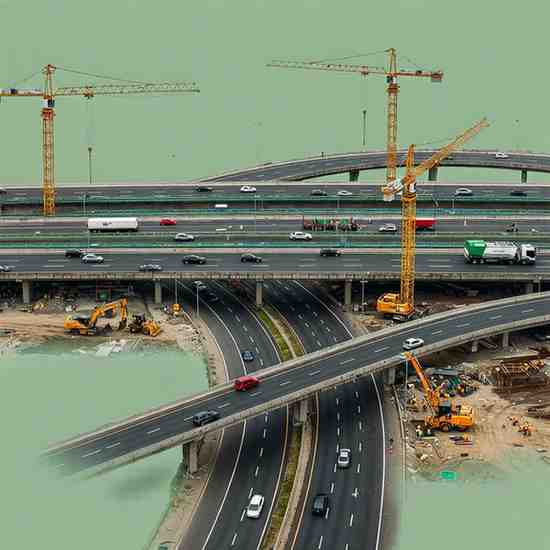
How Construction & Infrastructure Stocks Can Enhance Your Portfolio’s Diversification
How Construction & Infrastructure Stocks Can Enhance Your Portfolio’s Diversification
Portfolio diversification is a fundamental investment strategy aimed at mitigating risk by spreading investments across different asset classes, industries, and geographies. The idea is simple: by not putting all your eggs in one basket, you reduce the impact of a downturn in any single sector.
Thank you for reading this post, don't forget to subscribe!Among the many sectors available for investment, construction and infrastructure stand out as key components of economic growth. These industries play a crucial role in national development and are often supported by government policies and long-term economic trends. This blog explores how investing in construction and infrastructure stocks can contribute to a well-diversified portfolio.
The Importance of Portfolio Diversification
Diversification helps investors manage risk while optimizing potential returns. A well-diversified portfolio consists of various asset classes, such as equities, bonds, real estate, and commodities, each responding differently to market conditions.
Within the stock market, diversification across different sectors ensures that losses in one area can be offset by gains in another. For example, while technology stocks may experience volatility, infrastructure and construction stocks, often influenced by government spending and long-term contracts, can provide stability. Incorporating these sectors into a portfolio can help reduce overall risk and improve resilience during economic fluctuations.
Construction Stocks as a Diversification Tool
The construction industry encompasses residential, commercial, and industrial projects, making it a vital contributor to economic expansion. Several factors influence the performance of construction stocks, including:
- Economic growth: A booming economy often leads to increased construction activity.
- Government policies: Infrastructure spending, housing schemes, and regulatory changes can impact the sector.
- Interest rates: Higher interest rates can increase borrowing costs for developers, affecting profitability.
- Raw material prices: Fluctuations in material costs, such as cement and steel, impact construction margins.
Potential Benefits & Risks
Top performing Construction stocks can add cyclical exposure to a portfolio. During periods of economic growth, these stocks may experience significant appreciation. However, they can also be sensitive to economic slowdowns.
When evaluating construction stocks, investors should consider:
- Project pipeline: A strong backlog of projects ensures future revenue.
- Debt levels: Excessive leverage can be a red flag.
- Management expertise: Experienced leadership can navigate industry challenges effectively.
Infrastructure Stocks as a Diversification Tool
Infrastructure stocks cover various segments, including transportation (roads, railways, ports), energy (power generation, renewable energy), utilities (water supply, waste management), and communication (telecom networks). These businesses are often backed by government spending and regulatory frameworks, providing long-term growth potential.
Drivers of Infrastructure Development
- Government initiatives: Public-private partnerships and policy support fuel infrastructure expansion.
- Urbanization and population growth: Rising demand for housing, transportation, and utilities drives infrastructure investment.
- Technological advancements: Smart cities, renewable energy, and digital infrastructure are shaping the future of the sector.
Potential Benefits & Risks
Best performing infrastructure stocks investments offer long-term stability due to regulated revenue models and government contracts. Additionally, they can provide consistent income through dividends. However, risks include:
- Regulatory challenges: Changes in government policies can impact project feasibility.
- Capital intensity: High upfront costs and long gestation periods require substantial funding.
- Political and economic factors: Infrastructure projects may be influenced by government decisions and economic cycles.
Investors should assess companies based on:
- Regulatory environment: Favorable policies can enhance sector growth.
- Project viability: Strong financials and well-structured contracts indicate stability.
- Financial health: A solid balance sheet ensures the ability to execute large projects.
Relationship Between Construction and Infrastructure
Construction and infrastructure are not isolated sectors; they are deeply intertwined. Infrastructure projects often require the expertise and services of construction companies, while the growth of infrastructure fuels demand for construction materials and labor. This symbiotic relationship creates a powerful synergy that can benefit investors.
Construction as the Building Block of Infrastructure
Construction companies are the essential workforce behind infrastructure development. They build the roads, bridges, tunnels, power plants, and communication networks that form the backbone of a modern society.
Infrastructure as a Driver of Construction Demand
Government investments in infrastructure projects create a ripple effect, boosting demand for construction materials like cement, steel, and aggregates. This increased demand benefits construction companies and their suppliers.
Interdependence and Collaboration
Construction and infrastructure companies often collaborate on projects, with construction firms acting as contractors or subcontractors for larger infrastructure initiatives. This interdependence fosters innovation and efficiency within both sectors.
Benefits for Investors
This interconnectedness can create opportunities for investors. By investing in both construction and infrastructure companies, investors can gain exposure to the growth of both sectors, potentially benefiting from the synergies between them.
Strategies for Incorporating Construction and Infrastructure Stocks
There is no universal approach to portfolio diversification, but a few strategies can help investors integrate construction and infrastructure stocks effectively:
- Asset allocation: Determine the proportion of your portfolio to be invested in these sectors based on your risk appetite.
- Research and due diligence: Analyze industry trends, company financials, and competitive positioning before investing.
- Diversified exposure: Consider investing across multiple companies to mitigate risks associated with individual stocks.
- Consult a financial advisor: Professional guidance can help align investments with financial goals and risk tolerance.
- Regular review and rebalancing: Periodically assess the portfolio to ensure it remains aligned with your investment strategy.
Conclusion
Portfolio diversification is essential for managing investment risk and optimizing returns. Construction and infrastructure stocks offer unique advantages by providing exposure to economic growth, long-term stability, and potential income streams. However, careful selection and due diligence are crucial to making informed investment decisions.
Related Blogs:
Best Steel Stocks in India in 2025
What’s in the Union Budget 2025 for Infrastructure and Cement?
Top 5 Real Estate Stocks in India
Best Cement Stocks in India
Top 5 Infrastructure Stocks to Buy in India in 2025
Top 5 Cement Stocks in India
Disclaimer: This blog post is intended for informational purposes only and should not be considered financial advice. The financial data presented is subject to change over time, and the securities mentioned are examples only and do not constitute investment recommendations. Always conduct thorough research and consult with a qualified financial advisor before making any investment decisions.

